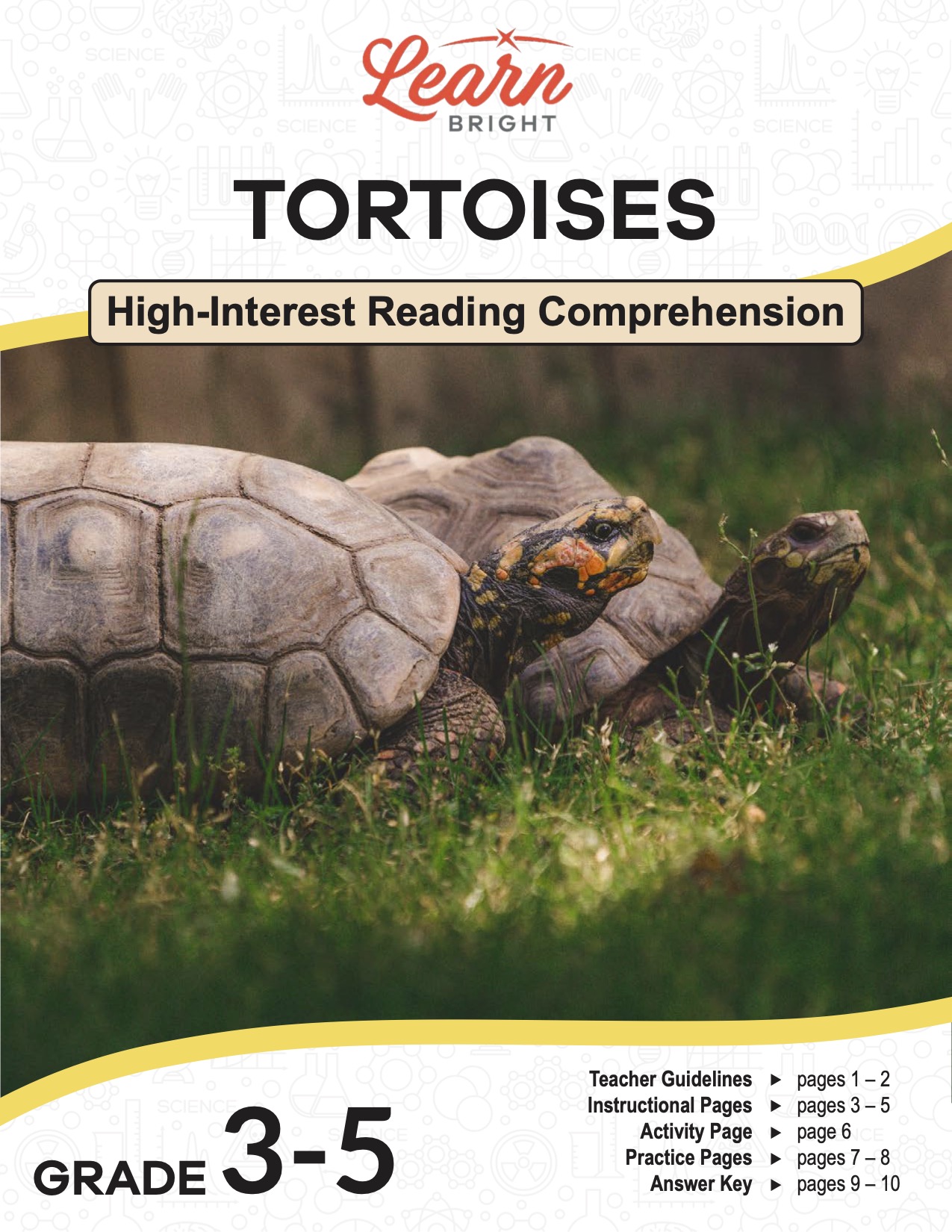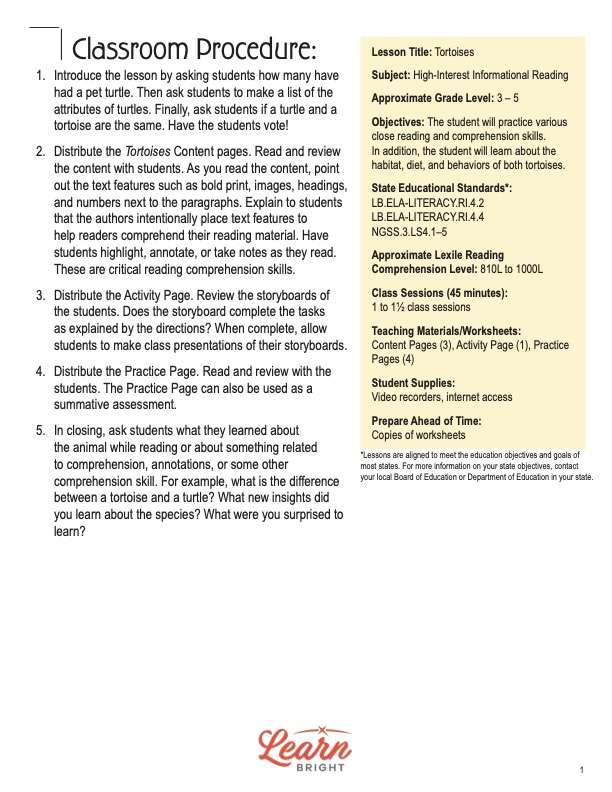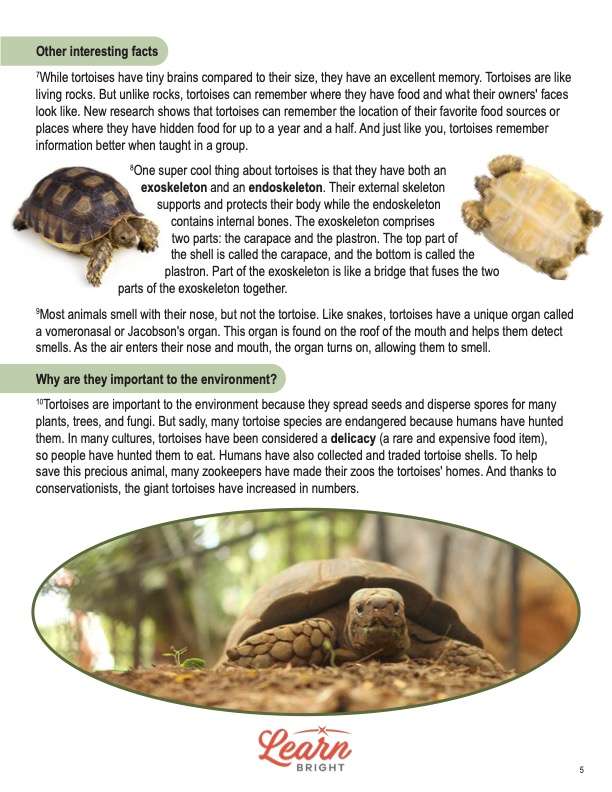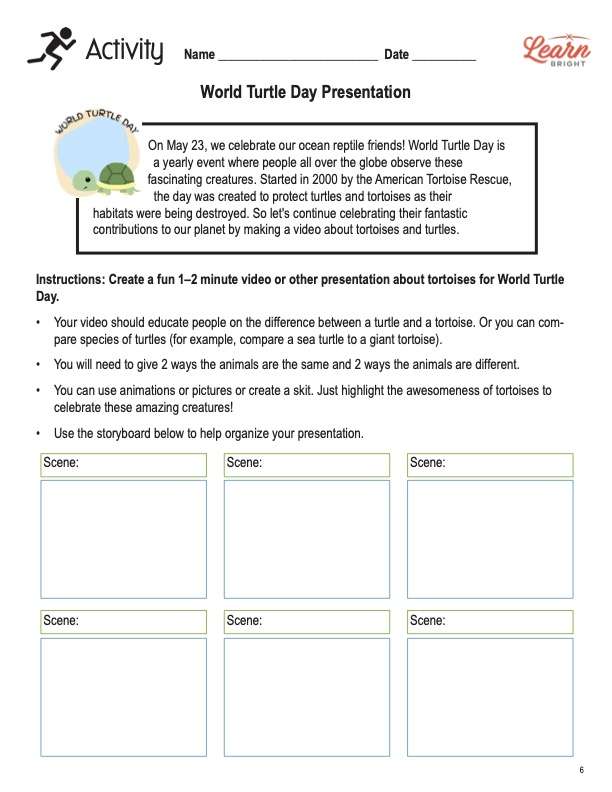Description
What our Tortoises lesson plan includes
Lesson Objectives and Overview: Tortoises is a high-interest reading comprehension lesson plan. As such, students will practice various close reading and comprehension skills. In addition, they will learn about the tortoise’s habitat, diet, and behaviors. This lesson is for students in 3rd grade, 4th grade, and 5th grade.
Classroom Procedure
Every lesson plan provides you with a classroom procedure page that outlines a step-by-step guide to follow. You do not have to follow the guide exactly. The guide helps you organize the lesson and details when to hand out worksheets. It also lists information in the yellow box that you might find useful. You will find the lesson objectives, state standards, and number of class sessions the lesson should take to complete in this area. In addition, it describes the supplies you will need as well as what and how you need to prepare beforehand. The activity in this lesson requires video recorders and access to the internet.
Teacher Notes
The teacher notes page provides an extra paragraph of information to help guide the lesson. It explains that you can teach this lesson in a whole-class setting or as an independent, small-group activity. You can use the blank lines to write down any other ideas or thoughts you have about the topic as you prepare.
TORTOISES LESSON PLAN CONTENT PAGES
What Is a Tortoise?
The Tortoises lesson plan contains three content pages. It begins by providing a box of background information about this animal. Tortoises are reptiles that are either herbivores or carnivores. They live everywhere except Antarctica. They can live anywhere between 20 and 150 years.
Many people think a tortoise and a turtle are the same animal, but that is only kind of true. Technically, all tortoises are also turtles, but not all turtles are tortoises. According to the zookeepers at the Nashville Zoo, “One major key difference is that tortoises spend most of their time on land and turtles are adapted for life spent in water.” So tortoises are almost exclusively land-dwelling. But most other turtles, on the other hand, are aquatic, meaning they enjoy life in the water. Tortoises also have a high domed shell on their back to protect them from predators as they roam the land. In addition, they have column-like hind legs to help them walk on land, but turtles have webbing that helps them swim.
Tortoises have existed for over 55 million years! They vary in size depending on the species. Some are very small, with shells less than five inches long, while others—like the Galápagos giant tortoise—are enormous, with shells almost four feet long. Tortoises are diurnal, which means they are most active during the day. Some get energy and are active around twilight but will fall asleep during the night. But most of the time, they behave very leisurely. And exactly how slow are tortoises? Well, they average a walking speed of less than one mile per hour.
These ancient animals can live for a very long time. If you get a tortoise as a pet, it will most likely live longer than you! Most species have a lifespan of 80 to 150 years, but some tortoises live for up to 200 years.
What Do They Eat?
Most tortoises are herbivores. They eat grass, flowers, leaves, and fruit. But some are omnivores and snack on insects, slugs, and worms as well. Let’s hope that’s not what you packed for your snack today! Many people keep tortoises as pets and feed them delicious plants and fruits. Some of their favorite plants to eat are alfalfa sprouts, dandelions, and prickly pear cactus. In comparison, aquatic turtles are omnivores as well and mostly eat other animals that live in the water, like tadpoles and snails.
Tortoises are very adaptable. Over time, they changed to eat different types of plants. Biologists noticed that some species had different types of necks. Those living on islands with tall plants had longer necks, and their shells around the neck are pointed upward to allow them to reach higher places. In contrast, those living on islands with low-growing plants did not have long necks or an upturned section of shell.
Other Interesting Facts
The longest-living land animal in the world is a tortoise. His name is Jonathan, and in 2023, he was 190 years old! He was around before cell phones, computers, or even airplanes. Another tortoise named Lonesome George was born in 1910 and didn’t pass away until 2012! If you ever see a group of tortoises all hanging out together, then you have seen a creep of tortoises. The term comes from the act that tortoises move so slowly; they creep along.
While tortoises have tiny brains compared to their size, they have an excellent memory. Tortoises are like living rocks. But unlike rocks, tortoises can remember where they have food and what their owners’ faces look like. New research shows that tortoises can remember the location of their favorite food sources or places where they have hidden food for up to a year and a half. And just like you, tortoises remember information better when taught in a group.
One super cool thing students will learn about tortoises is that they have both an exoskeleton and an endoskeleton. Their external skeleton supports and protects their body while the endoskeleton contains internal bones. The exoskeleton comprises two parts: the carapace and the plastron. The top part of the shell is called the carapace, and the bottom is called the plastron. Part of the exoskeleton is like a bridge that fuses the two parts of the exoskeleton together.
Most animals smell with their nose, but not the tortoise. Like snakes, tortoises have a unique organ called a vomeronasal or Jacobson’s organ. This organ is found on the roof of the mouth and helps them detect smells. As the air enters their nose and mouth, the organ turns on, allowing them to smell.
Why Tortoises Are Important
Tortoises are important to the environment because they spread seeds and disperse spores for many plants, trees, and fungi. But sadly, many tortoise species are endangered because humans have hunted them. In many cultures, tortoises have been considered a delicacy (a rare and expensive food item), so people have hunted them to eat. Humans have also collected and traded tortoise shells. To help save this precious animal, many zookeepers have made their zoos the tortoises’ homes. And thanks to conservationists, the giant tortoises have increased in numbers.
TORTOISES LESSON PLAN WORKSHEETS
The Tortoises lesson plan includes two worksheets: an activity worksheet and a practice worksheet. Each one will help students solidify their grasp of the material they learned throughout the lesson. You can refer to the classroom procedure guidelines to know when to hand out each worksheet.
WORLD TURTLE DAY ACTIVITY WORKSHEET
For the activity, students will create a fun video or other presentation about tortoises for World Turtle Day. The video should educate people on the difference between turtles and tortoises. Or students can compare and contrast specific species of turtles. The worksheet provides a storyboard template that students can use to organize their presentations.
TORTOISES PRACTICE WORKSHEET
The practice worksheet requires students to answer a series of 11 questions. These questions all relate to the content pages, so students will need to refer to them often for the answers. In addition, each question provides which reading tool the question corresponds to, such as text feature, vocabulary, or comprehension.
Worksheet Answer Keys
At the end of the lesson plan document is an answer key for the practice worksheet. The correct answers are all in red to make it easier for you to compare them with students’ responses. If you choose to administer the lesson pages to your students via PDF, you will need to save a new file that omits these pages. Otherwise, you can simply print out the applicable pages and keep these as reference for yourself when grading assignments.










